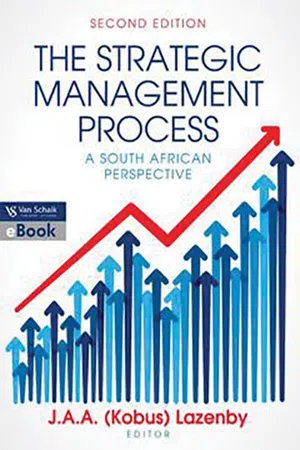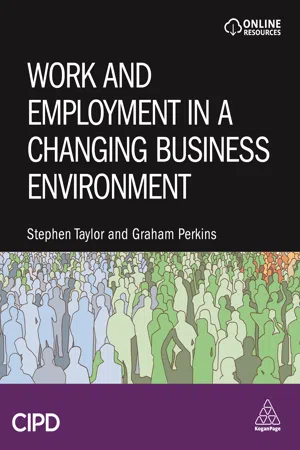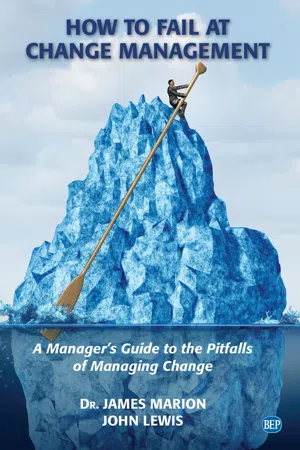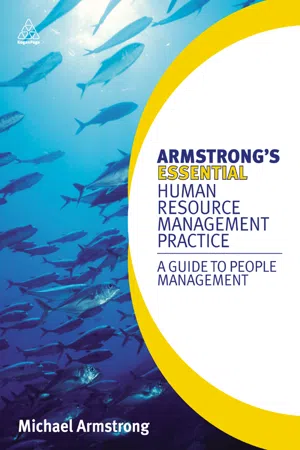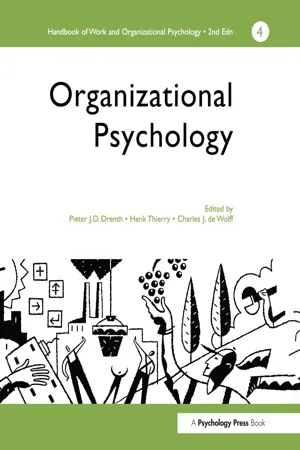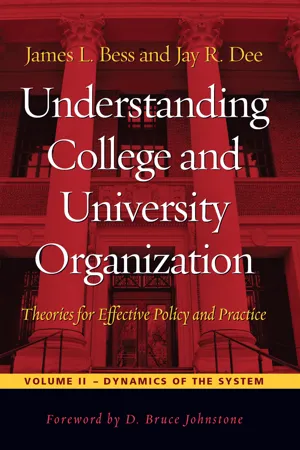Business
Lewin's Change Model
Lewin's Change Model is a three-stage framework for managing organizational change. It consists of unfreezing, where the status quo is disrupted; changing, where new processes or behaviors are introduced; and refreezing, where the changes are integrated and stabilized. This model emphasizes the importance of preparing for change, implementing it effectively, and then solidifying the new state to ensure lasting transformation.
Written by Perlego with AI-assistance
Related key terms
Related key terms
1 of 4
Related key terms
1 of 3
10 Key excerpts on "Lewin's Change Model"
- eBook - ePub
Strategic management process 2, The
A South African perspective
- Lazenby, K, Lazenby, K(Authors)
- 2018(Publication Date)
- Van Schaik Publishers(Publisher)
If the driving forces are increased but the restraining forces remain on place, organisational change will not take place. As long as the restraining forces remain in place, it becomes harder to use the driving forces and to see their effect. This can be explained by the effect of pushing against a spring – the more you push, the harder it becomes and as soon as you stop pushing the spring, it reverts back to its previous position. Lewin suggested that change would be easier and longer lasting if the restraining forceswere reduced, rather than increasing the driving forces. Lewin also suggested that modifying the forces that maintain the status quo may be easier than increasing the forces for change.It is, however, important to remember that this analysis is an investigative and analytical tool for diagnosing a problem, and is not intended for problem solving.14.3.2.2 Lewin’s change model
Lewin (1947a) developed a model that consists of three steps in order to understand change and to manage the change process. The application of this model will enable managers to help their employees progress through a strategic change situation.- Unfreezing. In order for change to take place, employees need to abandon their current practices and cultural norms. Unfreezing is a necessary step to change, because the previous ways of doing things will no longer be applicable. Employees sometimes realise that things are changing by identifying the changing behaviour of customers. The unfreezing of their current way of doing things is thus imminent. Managers can help with this step if they prepare employees for changes that must be implemented.354
- Moving to the next level. The required change is introduced. The amount of time this step will take depends on the number of changes and the nature of each change. Changes in organisational culture can take years, while changes in systems may be relatively easy and need only a short time.
- Refreezing.
- Stephen Taylor, Graham Perkins(Authors)
- 2021(Publication Date)
- CIPD - Kogan Page(Publisher)
Within the academic literature base that surrounds change management there are a number of differing models and understandings related to how we may effectively manage change. Many of these models have persisted for a surprisingly lengthy period of time, and there are lessons that can be drawn from them all. Within this part of the chapter a variety of the established change models are considered, and at various points readers are invited to critically reflect upon their implications for the change process. The first commonly referenced model of change was developed by Kurt Lewin (1947).Lewin: unfreeze–move–refreeze
Kurt Lewin is regarded very much as the founding father of what is understood as the field of change management (Cummings et al, 2016). His three-step model has arguably dominated western theories of change for a substantial period of time (Michaels, 2001), although there are questions about the applicability of his seminal theory in the modern business environment. Lewin’s core idea was that in order to change people’s views and obtain their support for proposed changes, leaders needed to adopt a three-step model, as represented in Figure 11.1 .Figure 11.1 Lewin’s change modelLewin used the metaphor of ice to describe the change process, arguing that it took time to ‘thaw out’ starting positions, creating a state that was moveable before change could occur. He argued that managers and leaders needed to advance a convincing case for change, which – if accepted by employees – would then enable movement to a new state, before the change could be embedded through a ‘refreezing’ process. It is widely acknowledged that the embedding of change (refreezing) can take substantially longer than creating the initial movement needed, with managers and leaders needing to enable the change to firmly take root.- eBook - ePub
Human Resource Management for Organisational Change
Theoretical Formulations
- Paritosh Mishra, Balvinder Shukla, R. Sujatha(Authors)
- 2021(Publication Date)
- Routledge(Publisher)
Odendaal, Robbins, & Roodt, 2004 ). These include:- Unfreezing the status quo;
- Movement to a new state or Changing behaviour;
- Refreezing the new change to make it permanent.
To start with the first phase, ‘Unfreezing’ can be defined as the “breaking away from the way things have been done” (Harper, 2011 , p. 18). In this phase, Kurt Lewin investigates how change is considered to provide equilibrium after two opposite forces interact with each other. These opposite forces are the ‘driving forces’ and the ‘restraining forces’ (Harper, 2011 ; Kritsonis, 2005 ). The former aims to bring and promote change, while the latter seeks to manage the status quo of the organisation. The maintenance of the status quo helps achieve stability and equilibrium in the organisation. In case organisations wish to change internally and adapt to external change, they need to move from this equilibrium stage and over individual (or employee) resistance and group conformity. For the unfreezing system to become effective, the ‘driving forces’ must always supersede the restraining forces. This is when the ‘unfreezing of the status quo’ is required. As per Lewin’s analysis, such unfreezing can be understood through his ‘Force Field Model’, where all surrounding elements like habits, customs, people, and attitude act as forces in bringing in change (Harper, 2011 ). Unfreezing can be achieved by pursuing three main elements. These include: increasing the driving forces that direct behaviour away from the status quo; decreasing the restraining forces that thwarts things move away from existing equilibrium; and lastly, finding a combination for the two elements listed herewith (Kritsonis, 2005 - eBook - ePub
How to Fail at Change Management
A Manager's Guide to the Pitfalls of Managing Change
- James Marion, John Lewis(Authors)
- 2020(Publication Date)
- Business Expert Press(Publisher)
In most cases, things get worse before they get better as stakeholders gradually work through the discomfort of doing something in a new way. Eventually, if the change is successful, performance improves. Lewin then informs the manager that the change must “refreeze” into the organization. This term is shorthand for “institutionalizing the new way of doing things” (Figure 1.2). Once the company is familiar with the new way of doing things to the point that it is no longer new, and the application of new processes and systems comes naturally, it could be said that refreeze and institutionalization of the change has occurred. Figure 1.2 Lewin’s model of managing change Source: Lewin (1947). Observations on Lewin The Lewin framework expresses what is observed in common-sense thinking about managing change. Change must begin, it must be carried out, and the change must become a way of life. While the Lewin framework provides a structured path to follow when initiating and managing change, the phases are expressed in a compact form and require elaboration by any given manager. Presumably, effective managers could successfully employ Lewin, whereas others, following the same three phases, could easily fail and often do. It appears from inspection of the process that the Lewin framework could emerge from a common-sense consideration of what ought to happen within a change management scenario. Further, the three steps in the Lewin framework could be viewed as phases or categories of activities. Change managers could take this and develop a project around it. This could be done by identifying the desired deliverables from “unfreeze,” “change,” and “refreeze” followed by populating a schedule with activities and resources. Kotter’s Eight-Step Change Model The Kotter’s change model provides detail and structure far beyond the three-phase Lewin model - eBook - ePub
Armstrong's Essential Human Resource Management Practice
A Guide to People Management
- Michael Armstrong(Author)
- 2010(Publication Date)
- Kogan Page(Publisher)
It is then necessary to decide how to get from here to there. Managing change during this transition state is a critical phase in the change process. It is here that the problems of introducing change emerge and have to be managed. These problems can include resistance to change, low stability, high levels of stress, misdirected energy, conflict and loss of momentum. Hence the need to do everything possible to anticipate reactions and likely impediments to the introduction of change.The installation stage can also be painful. When planning change there is a tendency for people to think that it will be an entirely logical and linear process of going from A to B. It is not like that at all. As described by Pettigrew and Whipp (1991), the implementation of change is an ‘iterative, cumulative and reformulation-in-use process’.Change modelsThe best known change models are those developed by Lewin (1951), Beckhard (1969), and Beer et al (1990).Lewin The basic mechanisms for managing change set out by Lewin are:- Unfreezing – altering the present stable equilibrium which supports existing behaviours and attitudes. This process must take account of the inherent threats change presents to people and the need to motivate those affected to attain the natural state of equilibrium by accepting change.
- Changing – developing new responses based on new information.
- Refreezing – stabilizing the change by introducing the new responses into the personalities of those concerned.
- Analyse the restraining or driving forces that will affect the transition to the future state. These restraining forces will include the reactions of those who see change as unnecessary or as constituting a threat.
- No longer available |Learn more
Creating High Performance Teams
Applied Strategies and Tools for Managers and Team Members
- Ray Aldag, Loren Kuzuhara(Authors)
- 2015(Publication Date)
- Routledge(Publisher)
In this chapter we examine ways to successfully facilitate change in its many forms. We discuss the change process, consider the process of identifying and managing forces for and against change, and address key sources of resistance to change. Then, we consider approaches to overcoming resistance to change, including when each is likely to be most effective. Finally, we address team-based insurrections and provide guidelines for dealing with difficult transitions.Before proceeding, complete Self-Assessment 8.1 on the text website. It gauges your general attitudes toward change. Then, complete Skills Practice 8.1 on the website to better understand how practicing managers deal with change.The Change Process
Change may be planned or reactive. Planned change occurs when team leaders or others develop and install programs or other activities to alter activities in a timely and orderly way. Reactive change occurs when team leaders or others simply respond to pressures for change when it comes to their attention. Planned change is often seen as superior to reactive change, especially when change is extensive and lengthy. However, both forms of change are important. Although it is clear that firms must take actions to anticipate and prepare for change, they must also have the flexibility and resources to recognize and respond to emerging demands and environmental shocks.Figure 8-1 The Lewin Change ModelWhether change is planned or reactive, understanding and implementing the steps in the change process will increase the chances for success. Kurt Lewin’s Change Model includes three general stages, shown in Figure 8-1 .1Figure 8-1 shows that successful change requires first creating a situation in which change is seen as necessary and desirable (unfreezing ), then taking steps to bring about the change (changing ), and finally ensuring that conditions are appropriate to reinforce the change (refreezing ). We address these steps throughout the remainder of the chapter.Skills Practice 8.2 on the text website will help you to develop skill in applying Lewin’s change process model to a realistic organizational situation. Be sure to address all three phases of the model. - eBook - ePub
A Handbook of Work and Organizational Psychology
Volume 4: Organizational Psychology
- De Charles, P J D Drenth, THIERRY HENK(Authors)
- 2013(Publication Date)
- Psychology Press(Publisher)
In his 1977 review of the same field, Alderfer describes OD as at once a professional field of social action and an area of academic study (p. 197) but then, as now, it is much more highly developed as a tool of professional consultancy than as an academic discipline. There seem to be at least two reasons for this. In the first place OD has grown out of efforts to improve managerial skills and was seen as part of investment in practical aspects of training within the personnel function. The available resources were therefore spent on the development of programmes rather than on research. The second reason is the inherent difficulty of applying traditional psychological assessment methods to this quite complex multi-faceted field. To begin with, it took OD some time before it was prepared to look at factors like organizational power, the existence of coalitions, the role of conflict, the role of unions, pressures from competitive markets, and other environmental forces (Wilpert, 1995).In the absence of a systems approach, which would include these facets, the aim of improving the effectiveness of organizations was illusory, though most traditional research methods would find it difficult to do justice to such an array of variables.One of the most widely used change theories and derivative methods stems from Kurt Lewin (1954), later adapted by Schein and Bennis (1965) and Schein (1980), and has three phases: unfreezing, changing, and refreezing. Though widely disseminated through the professional literature, consultancy and change-agent training, the difficulties are frequently sidestepped, though fully acknowledged by the originators. Schein (1980), for instance, draws attention to the following problems: (1) the change process cannot start before the previous attitudes or behaviour are first unlearned; this is difficult because they are deeply embedded in the personality and entrenched relationships; (2) unlearning attitudes, values, and self-images is “inherently painful and threatening” (p.209); (3) to unfreeze established patterns, they must be disconfirmed by the discovery that the assumptions, values, etc. are not validated; and (4) the disconfirmation “must set up sufficient guilt or anxiety to motivate a change” (p.210). This creates ethical problems for the change agent, who has to decide when it is right to induce discomfort, guilt, and anxiety without inflicting lasting psychological problems. - Shahron Williams van Rooij(Author)
- 2017(Publication Date)
- Routledge(Publisher)
Lewin’s conceptualization of change as a process and his 3-Step Model served as the basis of four well-known models that recommended a series of stages or phases for change agents to follow in implementing change. The Judson model (1991) postulated five phases of change implementation, namely: analysis and planning, communication, acceptance, changing to a desired state, and consolidation and institutionalization of the new state. The model included recommendations for overcoming resistance to change, such as alternative media, reward programs, bargaining, and persuasion. Kotter (1995) proposed an eight-step model for transformational change: (a) establish a sense of urgency by relating environmental conditions to challenges and threats to the organization; (b) form a powerful guiding coalition of individuals who firmly believe in the need for change and can inspire others to support change efforts; (c) create a vision of the desired end-state; (d) communicate the vision through multiple channels, (e) empower others to act by changing policies, procedures, systems, and structures in ways that will facilitate the implementation of change; (f) plan and create short-term wins by publicizing successes to build momentum; (g) build on the change and consolidate improvements; and (h) anchor the changes in corporate culture to sustain the new state. Unlike the Judson or Lewin models, the Kotter model focused on high-level executives seeking to lead transformational change and, as such, is not a good fit for change projects that are not transformative.A third model in the Lewin tradition is Galpin’s (1996) nine-wedge wheel model comprised of (a) establishing the need to change; (b) developing and disseminating a vision of planned change; (c) diagnosing and analyzing the current state; (d) generating recommendations; (e) detailing the recommendations; (f) pilot testing the recommendations; (g) preparing the rollout of the recommendations; (h) rolling out the recommendations; and (i) measuring, reinforcing, and refining the change. Central to Galpin’s model is an understanding of organizational culture as evident in rules and policies, norms, events, rewards, and recognition. Armenakis, Harris, and Fields (1999) focused on change messaging as a mechanism for facilitating change readiness and minimizing resistance to change, on the one hand, and facilitating adoption and institutionalization of the desired change, on the other hand. The change message should include the need for change, affirmation of the capability to change, the benefits of change, identification of those driving the change, and evidence that the change is right for the organization.- eBook - ePub
Understanding College and University Organization
Theories for Effective Policy and Practice: Volume II — Dynamics of the System
- James L. Bess, Jay R. Dee(Authors)
- 2023(Publication Date)
- Routledge(Publisher)
Sociotechnical theories suggest that it is more effective first to change the structure of the organization and then allow changes in organizational members’ attitudes to follow. The assumption is that structural redesign can enhance individuals’ propensities toward change. In contrast, human processual theories focus on the need to change people first, before organizationwide change can occur.Human Processual Theories (Lewin)
Psychologist Kurt Lewin (1951) was one of the first to develop an approach for analyzing the forces for and against change. His force field analysis recognized that resistance to change can be overcome when people understand and contrast the forces that may be leading them to resist (restraining forces) and the forces inducing them to change (driving forces). Consider, for example, a college that proposes to change a compensation system for faculty from stepped annual raises to a merit-based system. Figure 9.1 displays vectors that indicate the relative strength of the forces for and against change. At first, there may be an equilibrium between the forces for and the forces against change. In order to implement the change, one or more of the forces for change must be increased or one or more of the forces against change must be reduced, or some combination of the two.The use of force field analysis—a pictorial representation of the pressures promoting and impeding change—helps change agents diagnose more realistically and specifically the forces that are involved and their relative strength (Couger, Higgins, & McIntyre, 1993 ). Portraying the forces on a diagram further permits a decision about which forces are susceptible to change and to what degree they are changeable. Sometimes combinations of changes in both forces for and forces against can be arranged strategically to effect the desired change.Lewin also developed a mechanism for managing the process of change. It involves three steps: unfreezing, changing, and refreezing. Unfreezing - eBook - ePub
Change Leadership in Higher Education
A Practical Guide to Academic Transformation
- Jeffrey L. Buller(Author)
- 2014(Publication Date)
- Jossey-Bass(Publisher)
Chapter 2 Reframing ChangeIf, as we've seen, the organizational structure and culture of higher education means that colleges and universities are not well served by the change management strategies developed for corporate and military environments, what works better? Everyone knows there are plenty of changes already occurring throughout higher education today: globalization, the flipped classroom, increased competition, rapidly diminished resources, continually changing technology, and all the other factors that can be placed in the category I'll call received change. To these we can add all the changes we'd like to see in our programs: more creative teaching and active learning, higher levels of student success, more innovative research, progress in efficiency and effectiveness, higher levels of satisfaction, and all the other goals that we might call intentional change.Different Ways of Viewing Change
With so much change going on all around us, how can academic leaders approach their challenges and opportunities in ways that will most benefit the programs they supervise? Let's begin to answer this question by understanding that there are several different ways to look at change and that the perspective we take profoundly affects the way we lead others through a change process.The Common View of Change
If you were to go up to people on the street and ask them to define the word change, most of them would probably say it's about “making something different from what it was.” In other words, it was A before; it's B now. A has “changed into” B. This common view of change is what frequently makes people uncomfortable with the prospect of change: it suggests that you're always losing something. To use the Kübler-Ross model, it's like the old state we were in has died. “But what if I really liked A or at least liked key elements of A?” people might ask. “How do I know I'll like B better? And if A no longer exists and we realize that the change was a mistake, will it be possible to go back? Will we be giving up more than we will gain? Maybe the devil we know is better than the devil we don't?” We might call this common view of change the replacement view of change
Index pages curate the most relevant extracts from our library of academic textbooks. They’ve been created using an in-house natural language model (NLM), each adding context and meaning to key research topics.
Explore more topic indexes
Explore more topic indexes
1 of 6
Explore more topic indexes
1 of 4
